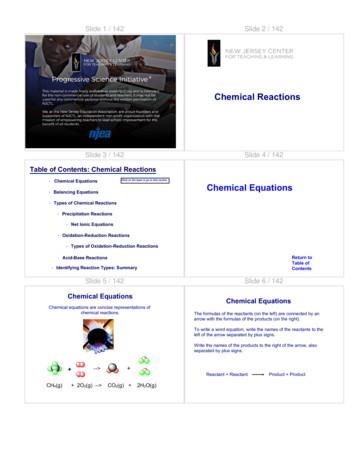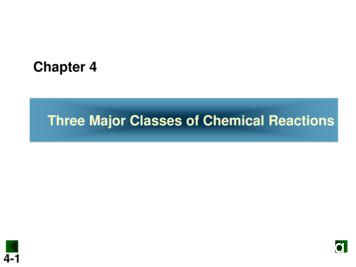Read About Chemical Reactions
READING MATERIALRead About Chemical ReactionsWHAT IS A CHEMICAL REACTION?A chemical reaction is a process in which new substances are formed. The atoms you startwith are regrouped into new substances that have different properties. It’s important toremember that the number of atoms before and after a chemical reaction always stays thesame.To better understand chemical reactions LET’S BREAK IT DOWN!When substances undergo chemical reactions, theirproperties change.All matter has properties, and thoseproperties can be both observed, andrecorded. Properties of matter can alsobe tested to help determine what thesubstance is. Examples of theseproperties are magnetism, flammability,density, and odor. Many other propertiesof matter exist and by examining asubstance’s properties, it can help uspredict how it may interact with othersubstances.Page 1
The total number of atoms does not change in a chemicalreaction.This is commonly known as the Law ofConservation of Matter. Because mattercannot be created or destroyed, atomscan only rearrange themselves in achemical reaction. For this reason, thefinal mass after a reaction has takenplace will be identical to the initial massbefore the reaction took place, even ifnew substances were formed. Atomscombine to form molecules, and thosemolecules interact with others differently based on their properties. When molecules interact witheach other, they rearrange to form new substances that have different properties than before.No new substances are formed in physical changes.Physical changes result in changes ofstate, or phase changes. They do notresult in new substances being formed.Melting and freezing are examples ofphase changes. Raising and loweringthe temperature of a substance causesmolecules to come closer together,forming a solid, or move farther apart,forming a liquid or gas. Many studentsthink dissolving is a physical (or phase)change. However, dissolving results from a chemical reaction taking place in which one substancebreaks down, instead of two substances combining to form a new substance. Chemical reactionscan also result in new substances when a substance breaks down after adding lots of energy. Anexample of this is TNT (trinitrotoluene)!Page 2
Reactants combine or rearrange to form products.Because matter cannot be created ordestroyed, when atoms rearrangethemselves in the presence of acatalyst, new substances are formedcalled products. These products usuallyhave different properties than thereactants, even though the totalamount of mass in the system has beenconserved. For example, lighting a gasgrill requires the combustion of propane.The chemical reaction looks like this:C3H8 (propane) 5O2 3CO2 4H2OThere are 10 atoms of oxygen on both sides of the equation, but the oxygen atoms have rearrangedthemselves combining with hydrogen and carbon to create carbon dioxide and water. The samenumber of atoms are present before and after the chemical reaction, but new substances havebeen formed into products.Many careers use chemical reactions to solve problems.Chemical engineers and materialscientists study chemical reactions toadvance space exploration, makemedicines, and form new products thatsolve unique problems. Professionalchemists work together with otherscientists to combine substances basedon their properties. The properties ofeach substance determines how itinteracts with other substances to formnew chemicals. Scientists study these properties and the interactions between substances to solveproblems and advance the world of science!CHEMICAL REACTIONS VOCABULARYPage 3
AtomsThe smallest particle of matter made up of protons, neutrons, and electrons.MoleculesMore than one atom combined to form a substance (e.g., oxygen – O2).ReactantsSubstances that are combined to form products in a chemical reaction.ProductsChemical changePhysical changeThe result of substances being combined in a chemical reaction.Chemicals combining to cause new substances to be formed.A change in state of matter where no new substance is formed.CHEMICAL REACTIONS DISCUSSION QUESTIONSHow is a physical change different from a chemical change?In a physical change, no new substances are formed. In a chemical change, new substances areformed.How do you know a chemical reaction has happened?If a new substance is formed, it has different properties.Give an example of a chemical change.Steel wool burning, which causes the iron to combine with oxygen and form iron oxide.How do you know this chemical reaction has taken place?By testing the properties before and after the reaction. Iron is flammable and will light on fire whentouched with a battery. After combining with oxygen, it is no longer flammable because theproperties have changed.Name three different properties you can test before and after a chemicalreaction to determine if a new substance was formed.Magnetism, flammability, electricity, density, and odorPage 4
What does a catalyst do in a chemical reaction?A catalyst helps the chemical reaction happen faster, but it does not become a part of the newsubstance.Page 5
To better understand chemical reactions LET’S BREAK IT DOWN! When substances undergo chemical reactions, their properties change. All matter has properties, and those properties can be both observed, and recorded. Properties of matter can also be tested to help determine what the substance is.
Chemical Reactions Slide 3 / 142 Table of Contents: Chemical Reactions · Balancing Equations Click on the topic to go to that section · Types of Chemical Reactions · Oxidation-Reduction Reactions · Chemical Equations · Net Ionic Equations · Types of Oxidation-Reduction Reactions · Acid-Base Reactions · Precipitation Reactions
Lesson Overview Chemical Reactions and Enzymes Chemical Reactions and Enzymes. Lesson Overview Chemical Reactions and Enzymes Chemical Reactions A chemical reaction is a process that changes , or transforms, one set of chemicals into another by changing the
Chemical reactions called _ reactions give off heat. 5. Other reactions called _ reactions absorb heat and cool the immediate environment. 6. True or False. During all chemical reactions, a chemical change takes place that produces new substances with properties different than those of the original substances. .
The Major Classes of Chemical Reactions. 4.6 Elements in Redox Reactions 4.1 The Role of Water as a Solvent 4.2 Writing Equations for Aqueous Ionic Reactions 4.3 Precipitation Reactions 4.4 Acid -Base Reactions. 4.5 Oxidation -Reduction (Redox) Reactions 4.7
Types of Reactions There are five main types of chemical reactions we will talk about: 1. Synthesis reactions 2. Decomposition reactions 3. Single displacement reactions 4. Double displacement reactions 5. Comb
ii. acid–base neutralization reactions iii. oxidation–reduction or redox reactions. Q.3. What are the important aspects of redox reactions? Ans: Almost every element participate in redox reactions. The important aspects of redox reactions are as follows: i. Large number of natural, biological and industrial processes involve redox reactions .
C.P. Chemistry Test Unit 8 Study Guide Chemical Equations and Reactions Recognize evidence of chemical change. Identify the reactants and products in a chemical reaction. Represent chemical reactions with equations. Know what is represented by the symbols: s, l, g, and aq. Categorize chemical reactions by type (synthesis/combination, decomposition,
Topic 8: Chemical Reactions Chemical Equations & Reactions (Chapter 8 in Modern Chemistry) Describing Chemical Reactions A chemical reaction is the process by which one or more substances are changed into one or more different substances. In any chemical reaction, the original substances are known as the























